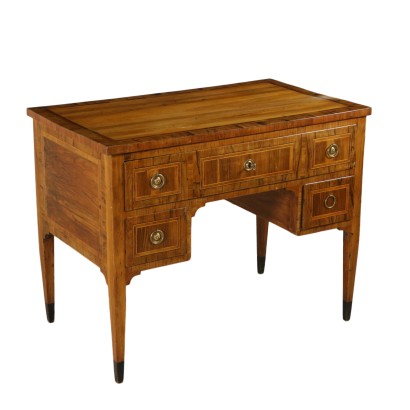Neoclassical Desk
Features
Style: Neo-Classical (1765-1790)
Age: 19th Century / 1801 - 1900
Year: Ultimo quarto '800
Origin: Italy
Main essence: Cherry , Various Wood Essences , Walnut , Olive
Description
An elegant desk supported by pyramidal legs, three drawers. Burr walnut parts edged with inlaid olive threads and various species. The edge of the table is slabbed with cherry wood. Manufactured in Italy, last quarter of the 19th century.
Product Condition:
The item shows signs of wear due to age. Any damage or loss is displayed as completely as possible in the pictures. It may require restoration and polishing.
Dimensions (cm):
Height: 79,5
Width: 102
Depth: 60
Additional Information
Style: Neo-Classical (1765-1790)
This historical period includes a first phase that can be properly defined as the Louis XVI style.nOnly at a later time, with the maturation of archaeological fashions, was a new vision of furnishing civilization formulated and codified, now fully attributable to the Neoclassical Style.
In fact, both trends coexisted in unison until the last years of the eighteenth century.
nIn the field of cabinet making, the Directoire, Retour d'Egypte, Consular and Empire styles also fall within the neoclassical era.
nFind out more about Neoclassicism with the insights from our blog...
n
Age: 19th Century / 1801 - 1900
19th Century / 1801 - 1900Main essence:
Cherry
Obtained from prunus cerasus , a plant of oriental origin, it is a hard wood with a light and delicate color, with a reddish vein. Due to its diffusion and availability it was used in Europe in popular furniture. In cabinet making, in the seventeenth century, it was widely used in France and England for inlay work. In Italy it was very successful in Lucca. It was also very popular in the United States for the manufacture, from the late 1600s, of commonly used furniture.The dictionary of antiques: Eclecticism
Classic Monday: a sofa from the 1800s example of eclecticism































